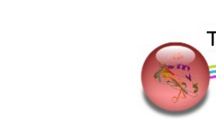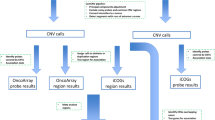Abstract
Purpose
Germline mutations in tumour suppressor genes cause various cancers. These genes are also somatically mutated in sporadic tumours. We hypothesized that there may also be cancer-related germline variants in the genes commonly mutated in sporadic breast tumours.
Methods
After excluding the well-characterized breast cancer (BC) genes, we screened 15 novel genes consistently classified as BC driver genes in next-generation sequencing approaches for single nucleotide polymorphisms (SNPs). Altogether 40 SNPs located in the core promoter, 5′- and 3′-UTR or which were nonsynonymous SNPs were genotyped in 782 Swedish incident BC cases and 1,559 matched controls. After statistical analyses, further evaluations related to functional prediction and signatures of selection were performed.
Results
TBX3 was associated with BC risk (rs2242442: OR = 0.76, 95% CI 0.64–0.92, dominant model) and with less aggressive tumour characteristics. An association with BC survival and aggressive tumour characteristics was detected for the genes ATR (rs2227928: HR = 1.63; 95% CI 1.00–2.64, dominant model), RUNX1 (rs17227210: HR = 3.50, 95% CI 1.42–8.61, recessive model) and TTN (rs2303838: HR = 2.36; 95% CI 1.04–5.39; rs2042996: HR = 2.28; 95% CI 1.19–4.37, recessive model). According to the experimental ENCODE data all these SNPs themselves or SNPs in high linkage disequilibrium with them (r 2 ≥ 0.80) were located in regulatory regions. RUNX1 and TTN showed also several signatures of positive selection.
Conclusion
The study gave evidence that germline variants in BC driver genes may have impact on BC risk and/or survival. Future studies could discover further germline variants in known or so far unknown driver genes which contribute to cancer development.

Similar content being viewed by others
References
Bray F, Ren JS, Masuyer E et al (2013) Global estimates of cancer prevalence for 27 sites in the adult population in 2008. Int J Cancer 1325:1133–1145
Ferlay JSI, Ervik M, Dikshit R, Eser S, Mathers C, Rebelo M, Parkin DM, Forman D, Bray F (2012) GLOBOCAN 2012 v1.0, Cancer Incidence and Mortality Worldwide: IARC CancerBase No. 11. Internet; Lyon, France: International Agency for Research on Cancer; 2013. http://globocan.iarc.fr. Accessed 05 Feb 2014
Frank C, Fallah M, Ji J et al (2014) The population impact of familial cancer, a major cause of cancer. Int J Cancer 1348:1899–1906
Olivier M, Hollstein MHainaut P (2010) TP53 mutations in human cancers: origins, consequences, and clinical use. Cold Spring Harb Perspect Biol 21:a001008
Sjoblom T, Jones S, Wood LD et al (2006) The consensus coding sequences of human breast and colorectal cancers. Science 3145797:268–274
Wood LD, Parsons DW, Jones S et al (2007) The genomic landscapes of human breast and colorectal cancers. Science 3185853:1108–1113
Teschendorff A, ECaldas C (2009) The breast cancer somatic ‘muta-ome’: tackling the complexity. Breast Cancer Res 112:301
Stratton MR, Campbell PJ, Futreal PA (2009) The cancer genome. Nature 4587239:719–724
Tomasetti C, Marchionni L, Nowak MA et al (2015) Only three driver gene mutations are required for the development of lung and colorectal cancers. Proc Natl Acad Sci USA 1121:118–123
Banerji S, Cibulskis K, Rangel-Escareno C et al (2012) Sequence analysis of mutations and translocations across breast cancer subtypes. Nature 4867403:405–409
Ellis MJ, Ding L, Shen D et al (2012) Whole-genome analysis informs breast cancer response to aromatase inhibition. Nature 4867403:353–360
Shah SP, Roth A, Goya R et al (2012) The clonal and mutational evolution spectrum of primary triple-negative breast cancers. Nature 4867403:395–399
Stephens PJ, Tarpey PS, Davies H et al (2012) The landscape of cancer genes and mutational processes in breast cancer. Nature 4867403:400–404
Kaaks R, Lundin E, Rinaldi S et al (2002) Prospective study of IGF-I, IGF-binding proteins, and breast cancer risk, in northern and southern Sweden. Cancer Causes Control 134:307–316
Purcell S, Neale B, Todd-Brown K et al (2007) PLINK: a tool set for whole-genome association and population-based linkage analyses. Am J Hum Genet 813:559–575
McShane LM, Altman DG, Sauerbrei W et al (2005) Reporting recommendations for tumor marker prognostic studies (REMARK). J Natl Cancer Inst 9716:1180–1184
Voight BF, Kudaravalli S, Wen X et al (2006) A map of recent positive selection in the human genome. PLoS Biol 43:e72
Oleksyk TK, Smith M WO’Brien SJ (2010) Genome-wide scans for footprints of natural selection. Philos Trans R Soc Lond B Biol Sci 3651537:185–205
Dai YGrant S (2010) New insights into checkpoint kinase 1 in the DNA damage response signaling network. Clin Cancer Res 162:376–383
Peasland A, Wang LZ, Rowling E et al (2011) Identification and evaluation of a potent novel ATR inhibitor, NU6027, in breast and ovarian cancer cell lines. Br J Cancer 1053:372–381
Heikkinen K, Mansikka V, Karppinen SM et al (2005) Mutation analysis of the ATR gene in breast and ovarian cancer families. Breast Cancer Res 74:R495–R501
Durocher F, Labrie Y, Soucy P et al (2006) Mutation analysis and characterization of ATR sequence variants in breast cancer cases from high-risk French Canadian breast/ovarian cancer families. BMC Cancer 6:230
Grimm-Gunter E M, Revenu C, Ramos S, et al., (2009) Plastin 1 binds to keratin and is required for terminal web assembly in the intestinal epithelium. Mol Biol Cell. 2010:2549–2562
Wang L, Brugge J SJanes KA (2011) Intersection of FOXO- and RUNX1-mediated gene expression programs in single breast epithelial cells during morphogenesis and tumor progression. Proc Natl Acad Sci USA 10840:E803–E812
Ramaswamy S, Ross KN, Lander ES et al (2003) A molecular signature of metastasis in primary solid tumors. Nat Genet 331:49–54
Chimge N, OFrenkel B (2013) The RUNX family in breast cancer: relationships with estrogen signaling. Oncogene 3217:2121–2130
Shield PW, Papadimos D JWalsh MD, (2014) GATA3: a promising marker for metastatic breast carcinoma in serous effusion specimens. Cancer Cytopathol
Tamborero D, Gonzalez-Perez A, Perez-Llamas C et al (2013) Comprehensive identification of mutational cancer driver genes across 12 tumor types. Sci Rep 3:2650
Douglas N, CPapaioannou VE (2013) The T-box transcription factors TBX2 and TBX3 in mammary gland development and breast cancer. J Mammary Gland Biol Neoplasia 182:143–147
Washkowitz AJ, Gavrilov S, Begum S et al (2012) Diverse functional networks of Tbx3 in development and disease. Wiley Interdiscip Rev Syst Biol Med 43:273–283
Kandoth C, McLellan MD, Vandin F et al (2013) Mutational landscape and significance across 12 major cancer types. Nature 5027471:333–339
Lawrence MS, Stojanov P, Mermel CH et al (2014) Discovery and saturation analysis of cancer genes across 21 tumour types. Nature 5057484:495–501
Hosford S RMiller T W, (2014) Clinical potential of novel therapeutic targets in breast cancer: CDK4/6, Src, JAK/STAT, PARP, HDAC, and PI3K/AKT/mTOR pathways. Pharmgenomics Pers Med 7:203–215
Endo Y, Toyama T, Takahashi S et al (2013) miR-1290 and its potential targets are associated with characteristics of estrogen receptor alpha-positive breast cancer. Endocr Relat Cancer 201:91–102
Greenman C, Stephens P, Smith R et al (2007) Patterns of somatic mutation in human cancer genomes. Nature 4467132:153–158
Dowling JJ (2013) Titin and centronuclear myopathy: the tip of the iceberg for TTN-ic mutations? Neurology 8114:1189–1190
Mayans O, van der Ven PF, Wilm M et al (1998) Structural basis for activation of the titin kinase domain during myofibrillogenesis. Nature 3956705:863–869
Machado C, Andrew DJ (2000) Titin as a chromosomal protein. Adv Exp Med Biol 481:221–232 (discussion 232–236)
Bhosale SJ, Kshirsagar AY, Sulhyan SR et al (2013) Rhabdomyosarcoma of the breast—a rare malignancy. Am J Case Rep 14:250–252
Lawrence MS, Stojanov P, Polak P et al (2013) Mutational heterogeneity in cancer and the search for new cancer-associated genes. Nature 4997457:214–218
Acknowledgments
We thank Åsa Ågren (Department of Public Health and Clinical Medicine/Nutritional Research, Umeå University, Sweden) for her commitment in keeping track of the samples and data and the Northern Sweden Breast Cancer group for providing the clinical data.
Author information
Authors and Affiliations
Corresponding author
Ethics declarations
Conflict of interest
None.
Electronic supplementary material
Below is the link to the electronic supplementary material.
Rights and permissions
About this article
Cite this article
Göhler, S., Da Silva Filho, M.I., Johansson, R. et al. Functional germline variants in driver genes of breast cancer. Cancer Causes Control 28, 259–271 (2017). https://doi.org/10.1007/s10552-017-0849-3
Received:
Accepted:
Published:
Issue Date:
DOI: https://doi.org/10.1007/s10552-017-0849-3




